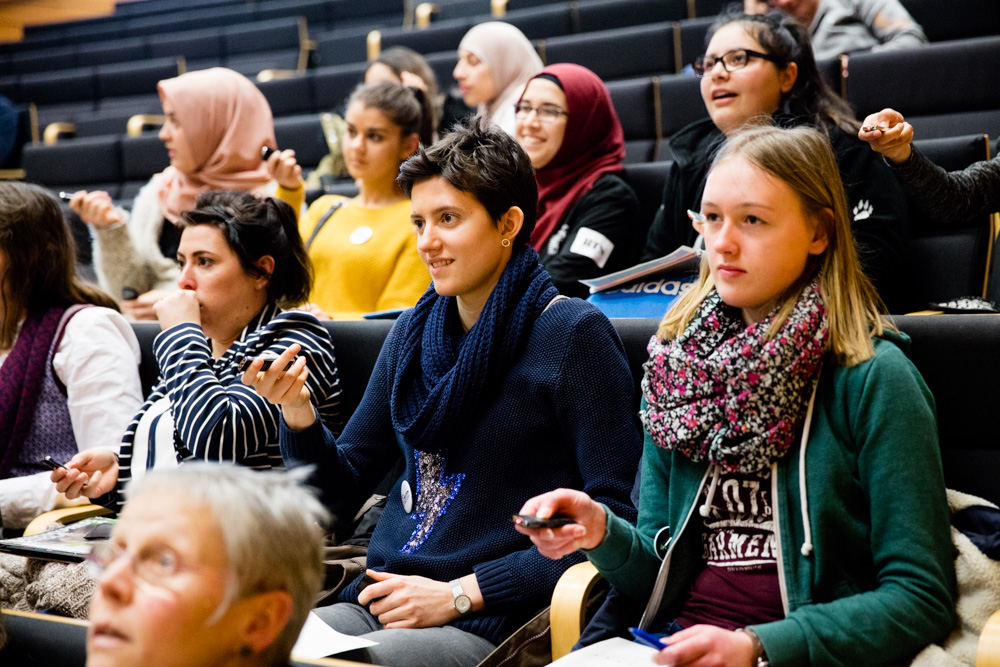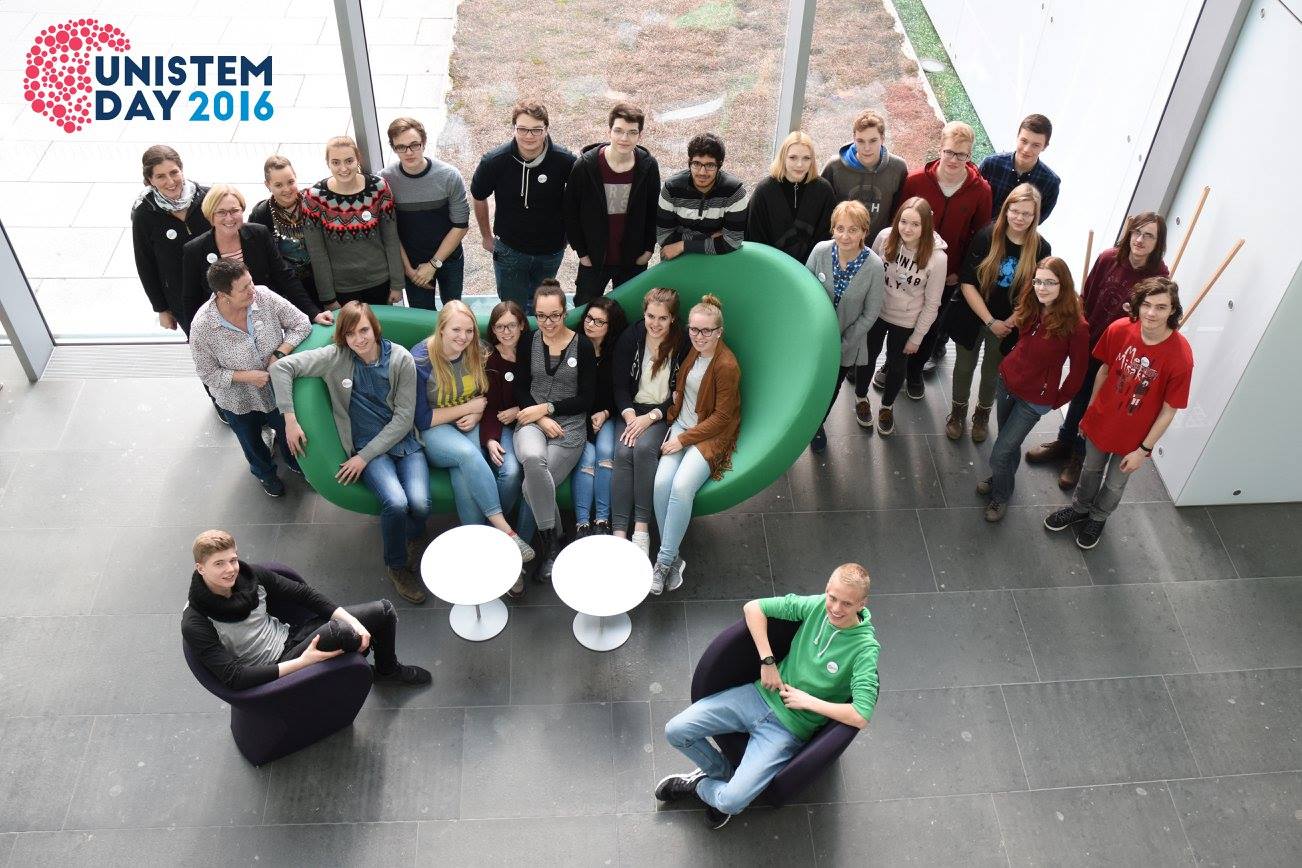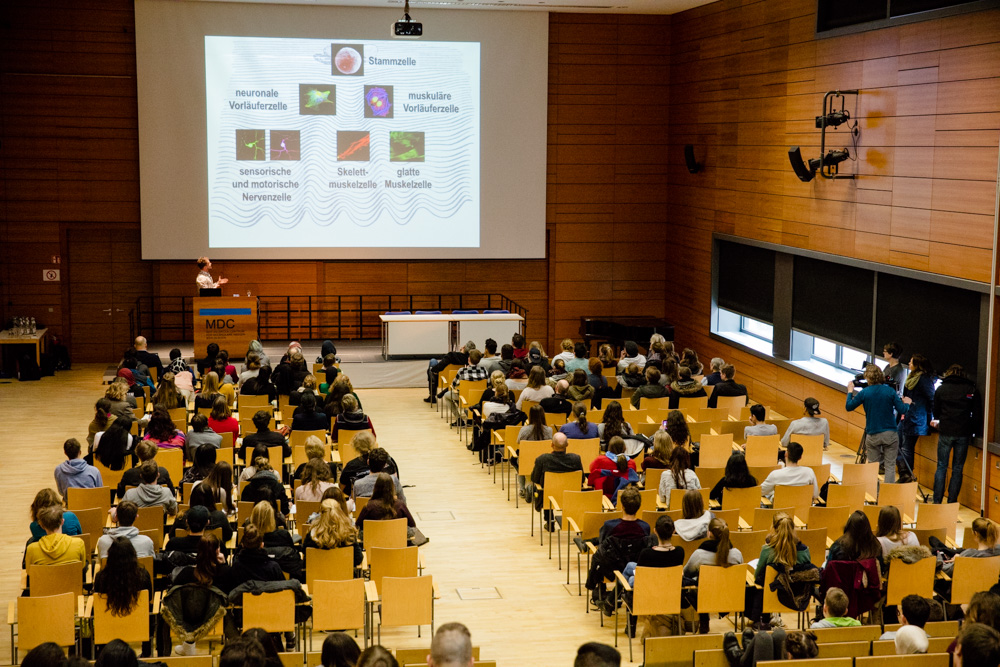Advancing awareness and understanding: GSCN public outreach work

Stefanie Mahler reflects on a year of public engagement at the German Stem Cell Network. Read about GSCN's full year in review here.
On March 11, 2016, groups of school students flocked to scientific institutions in eight German cities, researchers kitted themselves out with nametags and steeled their nerves, and heart surgeons explained to the youngsters how stem cells can be used to treat cardiac disease. It was all part of a major campaign that gave 1,000 high school students children across Germany the chance to spend the day learning about stem cells. The GSCN’s public outreach work aims to present stem cell research in a simple and intelligible way to all interested parties. It uses a wide variety of different tools and methods to do so, including lectures, one-to-one conversations, videos, interactive games, lab tours, hands-on experiments, exhibitions, flyers and articles, and is constantly adding creative new formats to the list. Students in Hannover were even allowed to watch a lung transplant as part of the public outreach campaign, all in the name of raising awareness and interest in stem cell research and to enable people to form well-founded opinions on the issues concerned. Science communicators are always on the search for new ideas to get particular groups interested in this rapidly advancing field.

In spring 2016, the target group were high school students taking part in Germany’s first UniStem Day. The German Stem Cell Network and participating institutes had spent one year organizing and planning this event to make it a success. UniStem Day is the first centrally organized educational day in Germany dedicated purely to stem cell research. The goal of the event was for exhausted and fascinated students to go home in the evening with an understanding of the potential of stem cells, the significance of their versatility, and what cell reprogramming is all about. They would have grasped why research is not the same as treatment, why research often seems to take so long, how to become a researcher and why it is so important that ethics, reflection and social debate accompany developments in stem cell research. These kinds of public outreach activities are designed to introduce young people, future researchers and future patients and their relatives to the fascination and also the realities of research at a very early stage.
The GSCN has set itself the task of advancing awareness and understanding of stem cells within society. It aims to present the complex web of scientific findings, the associated ethical implications and the long developmental path towards translation, clinical trials and treatments in a way that is understandable to the general public and to decision-makers. This also means that stem cell researchers must be prepared to listen to the fears and concerns of diverse civic groups and individuals and explain the facts in formats such as panel discussions and interviews. “I recently took part in a discussion on stem cell research with theologians and Catholic business people and it proved to be extremely interesting and enriching for both sides,” says GSCN managing director Daniel Besser, who appreciates opportunities to discuss the subject with groups traditionally situated at the opposite end of the spectrum. “Stem cell research is a very complicated field so we cannot expect everybody to immediately understand the material and the implications involved.” For the GSCN, it is therefore important that its public outreach activities include many different formats that match the level of knowledge and communication styles of all the various target groups in question, from students to patients and the elderly. “We tend to find that elderly people are particularly interested in our public events and specially designed series of exhibitions on stem cells and disease,” explains Besser. Short videos on stem cell researchers and their work are shown at the GSCN events to give participants an easily understandable introduction to the debate. It is absolutely essential to stick to the facts. The GSCN takes care not to exaggerate the achievements of the research or play down or ignore the associated risks. “It is very important to us not to stir any unfounded fears or raise unfounded hopes,” says Besser.

The need to improve public understanding and for effective science communication became apparent when stem cell research first came into the public eye in a big way. The media attention generated by a stem cell researcher’s application to use human embryonic stem cells for research purposes in 2002 and the discovery of iPS cells in 2006 sent the demand for information and debate through the roof.

“A lot of journalists and patients called us up at the institute asking about stem cells, iPS cells and the opportunities and risks involved,” says Tobias Cantz. He was working at the Max Planck Institute for Molecular Biomedicine in Münster at the time, in the laboratory of Hans Schöler, the researcher at the center of the attention in 2006. “As a physician, I am experienced in telling patients carefully but clearly about their medical situation and their treatment options. I transferred this attitude to the way I approached the general public.” In Münster, one of the hotspots of the debate on stem cell research, biomedical scientists and ethic experts set up a website on stem cell research in partnership with the Protestant Church. It is called Zellux and is targeted at schoolteachers and school students. “We wanted to create a website that provides validated high-quality information on the subject. The internet was awash with so much unverified information at the time, some of which was completely unfounded and absurd. So we wrote all of the information and teaching material for the site ourselves.” Since then, Tobias Cantz has been not just a researcher but also passionately involved in public outreach work. Even after ten years of experience working with school classes and teachers, the young professor still takes a keen interest in observing and contributing to the development of students’ attitudes and arguments. “I consider this is a really important part of my work. It gives me the chance to hear the opinions of the younger generations and I particularly enjoy talking with them about ethical principles.” His work with young people keeps Cantz curious. And he has noticed that the vehemence of the public debate on stem cell research has declined and been replaced by a more practical take on ethics. Asked about his wishes for the future, he says that he would like to provide students with even better information so that they can better understand and discuss the dynamics, the potential and also the ethical issues involved in recent developments in biomedicine. To achieve this and also to counter knowledge gaps in the future, Cantz is currently serving as expert advisor for the teaching material being developed for schools by the German Stem Cell Network and the Ernst Schering Foundation.
“One of the first target groups of our public outreach work were politicians,” says Ira Herrmann, coordinator of the GSCN working group on public outreach together with Tobias Cantz, reflecting on her time as managing director of the competence network for stem cell research of North-Rhine Westphalia. Following Prof. Oliver Brüstle’s application to use embryonic stem cells for research purposes in 2002, she was inundated with inquiries on the topic. She focused her public relations work on politicians and the press but also served the information needs of interested members of the general public. The research findings reported on by the media soon sparked the interest of another group, namely patients. “They called us desperately wanting treatment that we were obviously not able to provide. It’s sometimes difficult to offer objective advice in such cases,” says Ira Herrmann. She came up with a new approach to help remedy this situation, initiating a lecture as part of further training measures for family physicians to inform them about the opportunities and risks of stem cell therapies. “We were thus able to reach out to the disseminators who are the first point of contact in healthcare matters and are often in direct contact with people with chronic illnesses over many years,” says Hermann. In the first few years Hermann provided patients directly with information in English from Canada and the US before she created a German website on the subject together with the competence network team. In 2016, she summarized the facts and questions on non-validated therapies and important aspects for patients in a flyer on behalf of the GSCN. This gives patients answers to their most pressing concerns and puts them in a position to ask the right questions themselves, for example of providers of stem cell therapies.
The German Stem Cell Network has engaged in a variety of new activities since 2013, including public panel discussions and films on German stem cell researchers and their work, all of which are designed to encourage the interested public to think about stem cells. “We have been able in the meantime to develop a range of tried and tested methods to reach as many groups as possible,” says Daniel Besser. The biggest campaign so far was UniStem Day, and the most recent effort is to create up-to-date teaching material for four teaching modules, presented to students in the form of a conference. The network is now setting its sights on creating a film portal with GSCN-produced researcher portraits, like the ones in the United Kingdom that have made it onto the bestseller click list of the European outreach network EuroStemCell.
Mis à jour par: Stefanie Mahler
Dernière mise à jour: